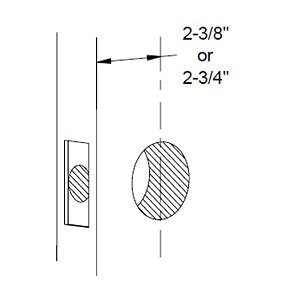
Let’s imagine you’re trying to fit a puzzle piece into the wrong spot. Even if it’s a perfect piece, it won’t work because it’s not meant for that place. The same idea applies here: a knob with the wrong backset size won’t fit your door properly. So, whether you’re replacing an old knob or installing a new one for the first time, understanding backset sizes is essential. Ready to dive in? Let’s break it down.
What is Backset Size?
Backset size refers to the distance from the edge of the door to the center of the knob or lock. It’s a specific measurement and typically comes in two standard sizes: 2-3/8 inches and 2-3/4 inches. Here’s how it works: If you take a measuring tape and measure from the edge of the door to where the knob or lock sits, that measurement is your backset size.
Why does it matter? Using the correct backset size ensures that your door knob sits comfortably in your hand and allows the lock to function properly. If you choose a backset that’s too long or too short, your door might not latch correctly, leaving it vulnerable to security risks or just plain annoying to use.
Standard Sizes: 2-3/8 Inches vs. 2-3/4 Inches
Let’s talk about the two most common backset sizes.
– 2-3/8 Inches: This size is typically used in residential doors. It’s a favorite among homeowners because most interior and exterior doors are designed around this measurement. If you’re replacing knobs in a standard home, chances are you’ll need this size.
– 2-3/4 Inches: This one is less common but still crucial, especially in commercial doors or heavier-duty applications. You might find this size in older homes or specific security doors that require a deeper set for enhanced locking mechanisms.
So, how do you decide which backset size is right for you?
Check Your Door
The first step is to measure your door. Grab a tape measure and check from the edge of the door to the center of the existing knob or lock. If you’re replacing a knob, this is simple. If you’re installing a new knob, you may need to consider your door’s current design.
Consider the Type of Door
Different doors often require different backset sizes. For example, if you have sliding glass doors or French doors, they may have unique specifications that lean towards either size. Make sure to know what you’re working with before you make your purchase.
Why Choosing the Correct Backset Size Matters
You might be wondering, “Is it that important?” Here’s the thing—choosing the wrong backset size can lead to several issues.
– Installation Issues: If you install a knob with the wrong backset, it can lead to misalignment. A misaligned knob can be frustrating to use and may not latch properly.
– Aesthetic Problems: A door knob that’s sitting too far in or out can ruin the overall look of your door. You want your hardware to be functional but also visually appealing.
– Security Risks: Misalignment can jeopardize the locking mechanism, making it easier for someone to break in. This is especially true for exterior doors, where security is key.
How to Measure Backset Size
Measuring backset size is straightforward once you know what to look for. Here’s how you can do it easily:
1. Gather Your Tools: You’ll need a tape measure and possibly a screwdriver if you need to remove the existing knob.
2. Remove the Existing Knob (if necessary): If you’re replacing a knob, unscrew it to get a clearer measurement.
3. Measure from the Edge: Place your tape measure against the edge of the door and extend it to the center of the hole where the knob sits. That measurement is your backset size.
4. Confirm with a Second Measurement: It never hurts to double-check. Take the measurement again to ensure accuracy.
If you find a 2-3/8 inches backset, you’re all set for most applications. But if it’s 2-3/4 inches, make sure to note that for future installations.
Common Problems with Backset Sizes
Choosing the wrong backset size can lead to some frustrating challenges. Here are a few common problems you might face:
– Door Doesn’t Latch Properly: If the backset is too short, the latch may not engage correctly, leaving your door partly open and less secure.
– Knob is Uncomfortable to Use: If the knob is positioned awkwardly, it can be hard to turn, leading to wear and tear.
– Difficulty in Installation: Installing a knob with the wrong backset can require extra modifications, which can stress you out more than necessary.
Alternatives to Standard Backset Sizes
If you find yourself in a pinch or dealing with outdated hardware, there are alternatives to the standard backset sizes.
– Adjustable Door Knobs: Some door knobs come with adjustable backsets, allowing you to set them to either size. This flexibility can save you time and hassle.
– Conversion Kits: If you’re determined to use a specific knob that doesn’t match your backset size, conversion kits can help adapt your door.
– Consult a Professional: If all else fails, consider hiring a handyman. They can quickly assess your door and make necessary adjustments to ensure everything fits well.
Final Thoughts on Backset Sizes
Understanding the different backset sizes for door knobs is essential for anyone involved in home improvement. Whether you’re a newbie tackling your first DIY project or a seasoned pro, getting the backset right can improve both the appearance and functionality of your doors.
The 2-3/8 inches and 2-3/4 inches sizes serve distinct purposes, and knowing which one suits your needs helps you avoid those pesky installation problems. So, grab your measuring tape, check your doors, and choose wisely. With the right information at your fingertips, you’ll be well on your way to a secure, functional, and good-looking door setup.